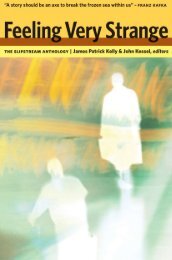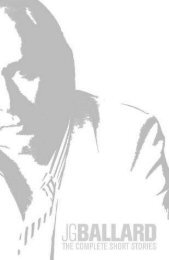The Curse of the Wer.. - Site de Thomas - Free
The Curse of the Wer.. - Site de Thomas - Free
The Curse of the Wer.. - Site de Thomas - Free
Create successful ePaper yourself
Turn your PDF publications into a flip-book with our unique Google optimized e-Paper software.
4 THE CURSE OF THE WEREWOLF<br />
For Žižek, this is <strong>the</strong> source <strong>of</strong> <strong>the</strong> Gothic monster’s ‘mo<strong>de</strong>rnity’;<br />
because <strong>the</strong> oppositional logic <strong>of</strong> <strong>the</strong> Enlightenment schemata cannot,<br />
ultimately, contain reality, ‘spectral’ manifestations such as <strong>the</strong> werewolf<br />
emerge to ‘complete’ <strong>the</strong> representations <strong>of</strong> reality facilitated by<br />
frameworks based upon polarities.<br />
Not surprisingly, studies focused on monstrosity as it materializes in<br />
<strong>the</strong> mo<strong>de</strong>s <strong>of</strong> <strong>the</strong> grotesque, <strong>the</strong> carnivalesque, <strong>the</strong> Gothic, <strong>the</strong> uncanny<br />
and horror have also proved sensitive to <strong>the</strong> manner in which figures<br />
such as <strong>the</strong> werewolf reveal patterns <strong>of</strong> subject- and i<strong>de</strong>ntity-formation<br />
in Western discourse. <strong>The</strong> existentialist insight that <strong>the</strong> self has been<br />
<strong>de</strong>fined negatively by its ‘o<strong>the</strong>rs’ has been wi<strong>de</strong>ly adopted in such<br />
contexts, with <strong>the</strong> Gothic, grotesque or uncanny being un<strong>de</strong>rstood as<br />
a mo<strong>de</strong> <strong>de</strong>voted to exploring <strong>the</strong> threat posed by <strong>the</strong> o<strong>the</strong>r to <strong>the</strong> self.<br />
Working within such a <strong>the</strong>oretical framework, a number <strong>of</strong> critics<br />
have i<strong>de</strong>ntified two different strands <strong>of</strong> Gothic or grotesque imagery,<br />
organized around an exterior–interior polarity. Put simply, some Gothic<br />
monsters are constructed as an externalized o<strong>the</strong>r threatening <strong>the</strong> self,<br />
while o<strong>the</strong>rs are shown to well up from within <strong>the</strong> realm <strong>of</strong> <strong>the</strong> self.<br />
As Chapter 2 <strong>de</strong>monstrates, <strong>the</strong> werewolf has embodied both kinds<br />
<strong>of</strong> grotesque imagery. In its monstrous lupine form, it is usually represented<br />
as an entirely alien o<strong>the</strong>r threatening <strong>the</strong> social collective. In<br />
representations <strong>of</strong> this type, <strong>the</strong> werewolf’s o<strong>the</strong>rness is constructed<br />
as <strong>the</strong> negative <strong>of</strong> a normalized social i<strong>de</strong>ntity. In its human form,<br />
however, (when its o<strong>the</strong>rness is interiorized), and during its transformation<br />
(when its hybridization <strong>of</strong> self and o<strong>the</strong>r becomes visible), <strong>the</strong><br />
werewolf is a consummate expression <strong>of</strong> <strong>the</strong> internalized grotesque. In<br />
<strong>the</strong>se latter representations <strong>of</strong> lycanthropy, <strong>the</strong> subjective experiences<br />
<strong>of</strong> <strong>the</strong> ‘universal’ subject are shown to be susceptible to contamination<br />
by <strong>the</strong> o<strong>the</strong>r. <strong>The</strong> werewolf’s facility for embodying both versions <strong>of</strong> <strong>the</strong><br />
grotesque draws attention to <strong>the</strong> Gothic mo<strong>de</strong>’s positioning as a site<br />
where sociological processes associated with <strong>the</strong> production <strong>of</strong> social<br />
‘reality’ and psychological processes associated with <strong>the</strong> production <strong>of</strong><br />
selfhood intersect, and <strong>de</strong>monstrates <strong>the</strong> extent to which each category<br />
produces and au<strong>the</strong>nticates <strong>the</strong> o<strong>the</strong>r within mo<strong>de</strong>rnity. In this context,<br />
Žižek’s un<strong>de</strong>rstanding <strong>of</strong> <strong>the</strong> mo<strong>de</strong>rn monstrous is useful, because it





